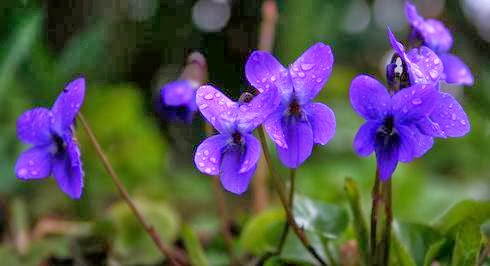Type of Flowers
Viola:
Viola is a genus of flowering plants in the violet family Violaceae. It is the largest genus in the family, containing between 525 and 600 species.Most species are found in the temperate Northern Hemisphere, however some are also found in widely divergent areas such as Hawaii, Australasia, and the Andes.
Some Viola species are perennial plants, some are annual plants, and a few are small shrubs. A large number of species, varieties and cultivars are grown in gardens for their ornamental flowers. In horticulture the term "pansy" is normally used for those multi-coloured, large-flowered cultivars which are raised annually or biennially from seed and used extensively in bedding. The terms "viola" and "violet" are normally reserved for small-flowered annuals or perennials, including the species.
The flowers of the vast majority of the species are zygomorphic with bilateral symmetry. The flowers are formed from five petals; four are upswept or fan-shaped petals with two per side, and there is one broad, lobed lower petal pointing downward. The shape of the petals and placement defines many species, for example, some species have a "spur" on the end of each petal while most have a spur on the lower petal.
Solitary flowers end long stalks with a pair of bracteoles. The flowers have 5 sepals that persist after blooming, and in some species the sepals enlarge after blooming. The flowers have five free stamens with short filaments that are oppressed against the ovary, only the lower two stamens have nectary spurs that are inserted on the lowest petal into the spur or a pouch. The flower styles are thickened near the top and the stigmas are head-like, narrowed or often beaked. The flowers have a superior ovary with one cell, which has three placentae, containing many ovules.
Viola are most often spring blooming with chasmogamous flowers with well-developed petals pollinated by insects. Many species also produce self-pollinated cleistogamous flowers in summer and autumn that do not open and lack petals.In some species the showy chasmogamous flowers are infertile.
Flower colours vary in the genus, ranging from violet, through various shades of blue, yellow, white, and cream, whilst some types are bicolored, often blue and yellow. Flowering is often profuse, and may last for much of the spring and summer.
Viola flowers used to decorate salads or in stuffings for poultry or fish. Soufflés, cream, and similar desserts can be flavoured with essence of Viola flowers. The young leaves are edible raw or cooked as a somewhat bland leaf vegetable. The flowers and leaves of the cultivar 'Rebecca', one of the Violetta violets, has a distinct vanilla flavor with hints of wintergreen. The pungent perfume of some varieties of V. odorata adds inimitable sweetness to desserts, fruit salads, and teas while the mild pea flavor of V. tricolor combines equally well with sweet or savory foods, like grilled meats and steamed vegetables. The heart-shaped leaves of V. odorata provide a free source of greens throughout a long growing season.
Many Viola species contain antioxidants called anthocyanins. Fourteen anthocyanins from V. yedoensis and V. prionantha have been identified. Some anthocyanins show strong antioxidant activities.Most violas tested and many other plants of the family Violaceae contain cyclotides,which have a diverse range of in vitro biological activities when isolated from the plant, including uterotonic, anti-HIV, antimicrobial, and insecticidal activities.
Viola odorata is used as a source for scents in the perfume industry. Violet is known to have a 'flirty' scent as its fragrance comes and goes. Ionone is present in the flowers, which turns off the ability for humans to smell the fragrant compound for moments at a time.

























No comments:
Post a Comment